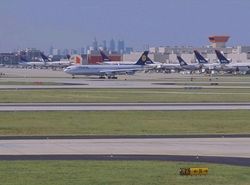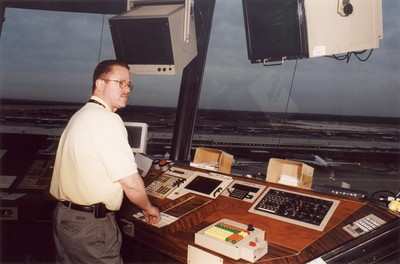Says Agency Should Have Standard Staffing Policies
 The National Air Traffic
Controllers Association (NATCA) is on a mission: to educate the US
airline traveling public about its concerns with FAA management
practices. As part of that process, the association held a
telephone press conference Tuesday to which it invited ANN.
The National Air Traffic
Controllers Association (NATCA) is on a mission: to educate the US
airline traveling public about its concerns with FAA management
practices. As part of that process, the association held a
telephone press conference Tuesday to which it invited ANN.
Making statements and answering questions were the association's
president, Patrick Forrey, as well as its director of
communications Doug Church, Tony Vella from the southern California
terminal radar approach control (SoCal TRACON) facility in San
Diego, Gary Briton a tower controller from Atlanta and Chicago air
route traffic control center (ARTCC) controller Jeff Richards.
NATCA's biggest beef with the FAA is staffing.
"The FAA is losing controllers at a staggering rate," said
Forrey, adding the agency is losing controllers at the rate of
three per day. Forrey claims the FAA has underestimated controller
loss rates for three years running, and the agency is now 1,100
short.
How did that happen? Forrey said it all started with the
controller strike in the early eighties when President Reagan fired
the whole workforce. That meant a tremendous number of controllers
were hired all at once, and now they all are -- or soon will
be -- eligible for retirement.
 Forrey said by 2012 over 7,000
controllers will have come eligible for retirement -- and he
believes most will accept even though the majority could work
longer.
Forrey said by 2012 over 7,000
controllers will have come eligible for retirement -- and he
believes most will accept even though the majority could work
longer.
Why? Forrey said flawed labor negotiations from just over a year
ago -- during which NATCA and the FAA reached impasse -- resulted
in "jailhouse work rules" and a two-tiered pay system that
eliminated raises for a large portion of the workforce.
Under current law, when the FAA and controllers can't agree on a
labor contract, Congress has 60 days to intervene. Should Congress
decline, the law allows the FAA to unilaterally impose its last
offer.
"It's not a fair process," said Forrey. NATCA wants to see that
law changed and force the FAA back to the bargaining table, perhaps
even under independent binding arbitration such as that enjoyed by
most other labor organizations.
Forrey said the FAA claims a large pool from which it
may hire potential controllers. But, he said, that pool will soon
dry up as those seeking jobs come to understand the current
realities. He said 56 newly-hired controllers recently resigned
when they didn't receive pay raises promised before the FAA imposed
its latest work contract.
 Under the new contract, according to
Forrey, a salary cap now in place means many experienced
controllers will never see another pay raise before reaching
mandatory retirement age. That eliminates the biggest incentive to
stay as a pay raise would increase a controller's pension as
well.
Under the new contract, according to
Forrey, a salary cap now in place means many experienced
controllers will never see another pay raise before reaching
mandatory retirement age. That eliminates the biggest incentive to
stay as a pay raise would increase a controller's pension as
well.
In an oft repeated mantra during the conference, Forrey said,
"We believe the FAA is managing to budget instead of managing to
safety."
So how is safety affected? Forrey said some controllers are
working six-day weeks because of the low staffing levels.
Additionally, he said the new work rules mean the FAA can force
controllers to man a position for more than two hours.
Forrey said he doesn't see staffing levels improving any time
soon. "The FAA is not hiring controllers, it's hiring trainees, and
trainees take two to four years to get certified and become useful
to the system. The gap between who can work and who can't is
growing larger," he said.
Atlanta tower's Gary Brittain said controllers there perform
duties for six to six-and-a-half hours per eight hour work day --
usually two hours actively handling traffic. He said there are 200
planes per hour going through the airport.
Under the old contract, FAA conducted manning studies to
determine staffing levels at ATC facilities. Then, Atlanta's tower
was authorized 56 controllers. Under the new contract, Atlanta has
34 fully-qualified controllers with five trainees. Of the 34
qualified, 12 are eligible to retire with nine of those expressing
plans to do so. Brittain said four have retired since October when
the new work rules went into effect.
 And Atlanta's staffing dropped
despite the addition of a new runway which further added to
the work load.
And Atlanta's staffing dropped
despite the addition of a new runway which further added to
the work load.
Brittain said the biggest issue for the remaining
controllers is fatigue. He claims the new rule limiting breaks
to 20 minutes doesn't give enough time to recover in
a high-stress work environment. Add in constant
overtime, and Brittain said you have a recipe for disaster.
"We believe we're prime in Atlanta for a human-factor error,"
claims Brittain.
He recounted a near-disaster that occurred at Atlanta on January
10 where a veteran controller issued a takeoff clearance for a 757
directly into oncoming traffic. Brittain said the controller
noticed his error and canceled the clearance as the jet reached 140
knots -- just two knots before rotation speed. Luckily, the jet was
using Atlanta's longest runway and was able to stop, but not
without overheating its brakes and blowing tires.
Brittain believes fatigue played a big role in the incident. He
said fatigue is cumulative and insidious. "When fatigue sets in,
you're the last guy to know you forgot something," he said.
In the January 10 incident, the controller who issued the
clearance had just taken over the position. Brittain said, the
off-going controller had worked 13 overtime shifts in the previous
six months, while the oncoming controller had worked seven overtime
shifts in the previous 15 weeks -- including an overtime shift the
day before.
Before a controller can leave a position he or she must brief
the current situation to the on-coming controller. Brittain said
shorter break times add to the pressure to get off position and to
the break area; in this case that pressure resulted in an
incomplete hand-off briefing.

Brittain adds the looming loss of experience makes the situation
even more scary. "Would a less-experienced controller have caught
and reacted appropriately to his error?" he asked. "We need to
hold on to experienced controllers and we're giving them incentive
to leave rather than stay."
Brittain wonders why Atlanta -- the world's busiest airport --
is staffed lower than Chicago. With the staggering number of
operations at both airports, the 30,000 fewer per year at Chicago
are insignificant according to Brittain, who says the work loads at
both are essentially identical.
So why then does Atlanta have only 34 qualified controllers
while Chicago enjoys 59?
Brittain said it's because regional leadership is free to staff
as they see fit. In Atlanta's case, he believes management seeks to
boost its annual bonuses by cutting costs -- one of the benchmarks
used to rate management's performance under the FAA's desire to run
itself as a business rather than a government service.
Brittain said NATCA doesn't understand the standards FAA uses to
determine manning levels. He said the tower manning disparity
between Atlanta and Chicago reflect differing priorities between
the regional leadership with "one prioritizing safety; the other
prioritizing costs."
Check back tomorrow to read about another harrowing
near miss NATCA claims was due to controller staffing, in Part Two
of this report.
 ANN's Daily Aero-Linx (05.06.25)
ANN's Daily Aero-Linx (05.06.25) ANN's Daily Aero-Term (05.06.25): Ultrahigh Frequency (UHF)
ANN's Daily Aero-Term (05.06.25): Ultrahigh Frequency (UHF) ANN FAQ: Q&A 101
ANN FAQ: Q&A 101 Classic Aero-TV: Virtual Reality Painting--PPG Leverages Technology for Training
Classic Aero-TV: Virtual Reality Painting--PPG Leverages Technology for Training Airborne 05.02.25: Joby Crewed Milestone, Diamond Club, Canadian Pilot Insurance
Airborne 05.02.25: Joby Crewed Milestone, Diamond Club, Canadian Pilot Insurance







